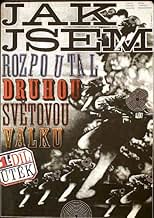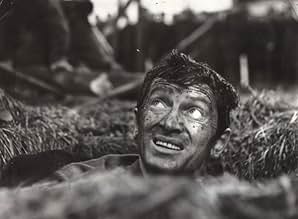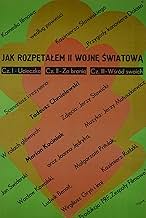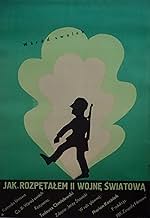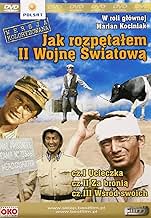Ajouter une intrigue dans votre langueThe adventures of unlucky Polish soldier Franek Dolas during world war II. In September he escapes from Stalag and goes to France. After that he fights in Africa and Europe.The adventures of unlucky Polish soldier Franek Dolas during world war II. In September he escapes from Stalag and goes to France. After that he fights in Africa and Europe.The adventures of unlucky Polish soldier Franek Dolas during world war II. In September he escapes from Stalag and goes to France. After that he fights in Africa and Europe.
- Réalisation
- Scénario
- Casting principal
Avis à la une
Contrary to what that one comment on the bottom says, there are so many moments during this movie that are so hilarious that you can hardly contain yourself. Its funny, and yet gives you a thing to think about. It's a classic and you won't be disappointed. The whole language realism makes it even better. I will say though, it is an especially long movie, consisting of 3 parts, each about an hour, but it is still worth every minute. I have heard people say that there is nothing funny about ww2. Well this exists, and this came out in a rather dark time in Poland's history, and that really goes to show how you can really make something terrible into something enjoyable. The fact that this came out from a communist film studio and that it is better than most modern movies is truly something else.
Filmed in 1970, Jak rozpetalem druga wojne swiatowa (How I Unleashed World War II) emerges from a period of Polish cinema marked by a complex tension between state-imposed ideological frameworks and an increasingly sophisticated audience that had learned to read between the lines. The film, despite its overt comedic tone, was produced in a decade when Polish cinema was heavily invested in exploring the traumas of war with both sincerity and irony. The late 60s and early 70s were also years of thaw and tightening, a pendulum of relative liberalization followed by reassertions of control. In this context, the film's comedic approach to World War II can be seen not merely as entertainment or escapism, but as a form of cultural negotiation-a way to preserve memory while simultaneously relieving its burden through absurdity.
Technically, the movie displays a surprisingly polished visual sensibility, particularly for a comedy that spans multiple geographies and military situations. Cinematography is crisp, occasionally even elegant, with a remarkable attentiveness to the iconography of the war film. The color palette shifts subtly across different segments, evoking the changing atmosphere-from the gray melancholy of POW camps to the ochres and dusty tones of the North African desert. This is not mere scenic variety but a deliberate stylistic choice that mirrors the protagonist's journey through a fractured continent at war. While the film doesn't aim for the stark verisimilitude of Cross of Iron (1977), it shares with it a sensibility that avoids romanticizing the combat experience. Where Peckinpah drenches the screen in nihilism and mud, this film weaponizes the absurd.
Editing is tight, with the comic rhythm supported by sharp cuts that never allow the tempo to drag despite the narrative's episodic structure. There's an almost Chaplinesque use of silence and pacing at times, especially in sequences where the protagonist stumbles into situations of escalating farce. These are not throwaway gags but carefully choreographed bits of cinematic mischief, designed with a deep understanding of spatial comedy. The camera is often static, allowing the absurdity to unfold within the frame, rather than chasing it with frantic movements-a choice that feels closer to the style of Jacques Tati than to most war comedies.
The sound design, while modest by today's standards, is used intelligently. Musical motifs are deployed sparingly but with maximum comedic and ironic effect, reinforcing the protagonist's status as an unwitting agent of chaos. The score avoids bombast, leaning instead on understated cues that blend seamlessly with the film's tonal ambiguity. The war is never entirely off-screen, but it's rarely foregrounded through sound; this creates a strange and effective tension where the stakes feel both enormous and absurdly personal.
Acting across the board is nuanced, with performances that stay just this side of caricature. The lead delivers a balancing act that is crucial to the film's tone: he's neither a complete fool nor an everyman hero, but rather a vessel through which the randomness and contradictions of wartime experience are explored. He avoids the pitfall of playing the role as slapstick; instead, his reactions remain grounded, often showing a resigned confusion that reflects a deeper commentary on the disorientation of the individual in a continent-wide catastrophe. Supporting roles, often played by non-professional or regional actors, add texture without distracting from the central thrust. There's a careful avoidance of sentimentalism-no mean feat for a war comedy-replaced instead by a humane cynicism.
In comparison to La Grande Vadrouille (1966), which shares a similar episodic narrative and comic tone, this film feels more grounded in the Eastern European tradition of fatalism. While La Grande Vadrouille revels in its Franco-British camaraderie and breezy defiance, the Polish film maintains a more ironic distance from heroism, reflecting a national memory far more entangled with occupation, resistance, and ambiguous survival. Likewise, compared to Stalag 17 (1953), which uses a POW setting to explore loyalty and suspicion with gallows humor, this movie treats the POW camp as one more absurd theatre in which the protagonist's cluelessness disturbs the social order, stripping away any illusion of stability even within captivity.
The film is particularly interesting when considered as a counterpoint to the dominant narratives of WWII cinema of its time. It's not concerned with glorifying resistance or suffering, nor does it seek to reconstruct battles or pay homage to fallen comrades. Instead, it aligns more with the comic-tragic tradition of Eastern European storytelling where survival often appears as a matter of chance, and where dignity is maintained not through solemnity but through the ability to laugh at the unbearable. That it was made in a socialist state and still allowed to frame the war through the eyes of a bumbling, accidental saboteur speaks volumes about the shifting boundaries of acceptability in Polish media at the time. It reflects an era when satire had become a subtle but powerful tool for navigating censorship-a method to both affirm and undermine official narratives.
The fact that the movie maintains a certain visual and tonal coherence across its multiple parts is testament to a strong directorial vision, even if at times the narrative momentum sags slightly under the weight of its length. Unlike many serialized or multi-part war comedies, it never fully tips into chaos or incoherence. There's a restraint that keeps the episodic madness from becoming repetitive. Each segment finds a new variation on the theme of accidental disruption, offering fresh settings, characters, and ironies.
There are moments, however, when the film's comedic strategy risks undermining its own historical texture. While the absurdist tone is one of its greatest strengths, it occasionally brushes too lightly against contexts-such as occupied territories or wartime atrocities-that demand more gravity. These tonal shifts are managed more gracefully than in some contemporary attempts at war comedy, but they nonetheless raise questions about the limits of the genre. The film stops short of vulgarization, but its refusal to ever fully engage with the horrors it skirts can feel evasive.
Still, this movie remains a rare example of a war comedy that manages to maintain historical specificity without becoming didactic or sentimental. It is very much a product of its time and place-rooted in a Polish historical consciousness that is acutely aware of both victimhood and farce, of martyrdom and misadventure. Its place in the canon of WWII cinema is unique: neither heroic epic nor bitter satire, it's an ambivalent, mischievous detour through the peripheries of wartime experience. In a genre often dominated by clear moral binaries and reverent solemnity, its playful irreverence and formal inventiveness offer a welcome, if disorienting, departure.
Technically, the movie displays a surprisingly polished visual sensibility, particularly for a comedy that spans multiple geographies and military situations. Cinematography is crisp, occasionally even elegant, with a remarkable attentiveness to the iconography of the war film. The color palette shifts subtly across different segments, evoking the changing atmosphere-from the gray melancholy of POW camps to the ochres and dusty tones of the North African desert. This is not mere scenic variety but a deliberate stylistic choice that mirrors the protagonist's journey through a fractured continent at war. While the film doesn't aim for the stark verisimilitude of Cross of Iron (1977), it shares with it a sensibility that avoids romanticizing the combat experience. Where Peckinpah drenches the screen in nihilism and mud, this film weaponizes the absurd.
Editing is tight, with the comic rhythm supported by sharp cuts that never allow the tempo to drag despite the narrative's episodic structure. There's an almost Chaplinesque use of silence and pacing at times, especially in sequences where the protagonist stumbles into situations of escalating farce. These are not throwaway gags but carefully choreographed bits of cinematic mischief, designed with a deep understanding of spatial comedy. The camera is often static, allowing the absurdity to unfold within the frame, rather than chasing it with frantic movements-a choice that feels closer to the style of Jacques Tati than to most war comedies.
The sound design, while modest by today's standards, is used intelligently. Musical motifs are deployed sparingly but with maximum comedic and ironic effect, reinforcing the protagonist's status as an unwitting agent of chaos. The score avoids bombast, leaning instead on understated cues that blend seamlessly with the film's tonal ambiguity. The war is never entirely off-screen, but it's rarely foregrounded through sound; this creates a strange and effective tension where the stakes feel both enormous and absurdly personal.
Acting across the board is nuanced, with performances that stay just this side of caricature. The lead delivers a balancing act that is crucial to the film's tone: he's neither a complete fool nor an everyman hero, but rather a vessel through which the randomness and contradictions of wartime experience are explored. He avoids the pitfall of playing the role as slapstick; instead, his reactions remain grounded, often showing a resigned confusion that reflects a deeper commentary on the disorientation of the individual in a continent-wide catastrophe. Supporting roles, often played by non-professional or regional actors, add texture without distracting from the central thrust. There's a careful avoidance of sentimentalism-no mean feat for a war comedy-replaced instead by a humane cynicism.
In comparison to La Grande Vadrouille (1966), which shares a similar episodic narrative and comic tone, this film feels more grounded in the Eastern European tradition of fatalism. While La Grande Vadrouille revels in its Franco-British camaraderie and breezy defiance, the Polish film maintains a more ironic distance from heroism, reflecting a national memory far more entangled with occupation, resistance, and ambiguous survival. Likewise, compared to Stalag 17 (1953), which uses a POW setting to explore loyalty and suspicion with gallows humor, this movie treats the POW camp as one more absurd theatre in which the protagonist's cluelessness disturbs the social order, stripping away any illusion of stability even within captivity.
The film is particularly interesting when considered as a counterpoint to the dominant narratives of WWII cinema of its time. It's not concerned with glorifying resistance or suffering, nor does it seek to reconstruct battles or pay homage to fallen comrades. Instead, it aligns more with the comic-tragic tradition of Eastern European storytelling where survival often appears as a matter of chance, and where dignity is maintained not through solemnity but through the ability to laugh at the unbearable. That it was made in a socialist state and still allowed to frame the war through the eyes of a bumbling, accidental saboteur speaks volumes about the shifting boundaries of acceptability in Polish media at the time. It reflects an era when satire had become a subtle but powerful tool for navigating censorship-a method to both affirm and undermine official narratives.
The fact that the movie maintains a certain visual and tonal coherence across its multiple parts is testament to a strong directorial vision, even if at times the narrative momentum sags slightly under the weight of its length. Unlike many serialized or multi-part war comedies, it never fully tips into chaos or incoherence. There's a restraint that keeps the episodic madness from becoming repetitive. Each segment finds a new variation on the theme of accidental disruption, offering fresh settings, characters, and ironies.
There are moments, however, when the film's comedic strategy risks undermining its own historical texture. While the absurdist tone is one of its greatest strengths, it occasionally brushes too lightly against contexts-such as occupied territories or wartime atrocities-that demand more gravity. These tonal shifts are managed more gracefully than in some contemporary attempts at war comedy, but they nonetheless raise questions about the limits of the genre. The film stops short of vulgarization, but its refusal to ever fully engage with the horrors it skirts can feel evasive.
Still, this movie remains a rare example of a war comedy that manages to maintain historical specificity without becoming didactic or sentimental. It is very much a product of its time and place-rooted in a Polish historical consciousness that is acutely aware of both victimhood and farce, of martyrdom and misadventure. Its place in the canon of WWII cinema is unique: neither heroic epic nor bitter satire, it's an ambivalent, mischievous detour through the peripheries of wartime experience. In a genre often dominated by clear moral binaries and reverent solemnity, its playful irreverence and formal inventiveness offer a welcome, if disorienting, departure.
As a Polish speaker and fan of WW2 films, this movie ticks all the boxes you would want from a WW2 adventure/comedy. One may describe the film as a cross between 'The Great Escape' (1964) and 'Forrest Gump' (1994). A simple mans comedic journey through a tumultuous time period in history, driven by his impassioned will to fight for his country.
This movie is one of the best polish movies there were ever made! The great story, the patriotism, the characters and most of all the irresistible humor have made this movie so special, that it entertains viewers of many generations! While most war movies show the terror of it, this movie shows it's brighter side. The side where people are brave, patriotic and they managed to do the impossible! Also shows how true is an old polish quote: "If a Pole wants to do something, he'll do it no matter how!" If you'd ask me, I'd gave you examples from my family that could prove those incredible situations! Hope you all will see it and like it as much as I do! Greycat R! Krystian Andrzej Dylewski
In Polish the movie was called "Jak rozpetalem druga wojne swiatowa". Translated into Russian, the name of the film looks like - "How I Unleashed World War II". But in our country it was released under the title "The adventures of Dolas the cannoneer".
Judging by the extremely small number of reviews on this film on IMDB and on the complete absence of references to this film on the Rotten Tomatoes website, this picture is practically unknown in the world. Except, perhaps, for Poland and Hungary. There is no data on the demonstration of the film in the USSR, but I definitely remember that I watched it being pupil of of either the 6th or 7th grade, i.e., somewhere in the beginning of 70-s.
And the second time I watched this movie recently. And it was interesting to compare my impressions with me then, half a century younger, and today.
I remember that then I laughed wildly at the session. A lot of funny moments in this movie.
Today, voluntarily or involuntarily, other points attracted attention. Well, firstly, I remember exactly that then, in the beginning of the 70s, the film consisted of two episodes and lasted a total of somewhere from two and a half to three hours. The full version, which I watched recently, lasts almost 4 hours and consists of 3 episodes. This is how much was cut out of the film by Soviet censorship! Weigh roughly - a whole third of the film. However, neither then nor today would I be able to sit in the movie theater for 4 hours on this film. It's good that now there is a lot of opportunities to watch movies at home on the couch.
Secondly, during a recent viewing, I drew attention to a phrase uttered by one of the female characters when the action took place in Yugoslavia: "The Germans will be here soon. They have already occupied Hungary." Then, in childhood, my friends and I did not pay much attention to this phrase. Of course, bad fascists occupied good Hungary. This is today, when we know that Hungary was the original and most faithful satellite of Nazi Germany and fought against the Red Army until the very end, when even the Germans themselves began to give up, this phrase cuts the ear. Since the Nazis had no need to "occupy" Hungary. At least, in 1939-1940.
Thirdly, I do not remember whether the episode with the Polish officers in the POW camp was present in the version that was shown in Soviet times, or not. Most likely not. Now compare with numerous photo documents about the camp conditions for Soviet officers in German camps for POWs. And as they say, feel the difference.
Such a comparison is especially relevant today, when some Polish, and not only Polish, politicians decided to attribute the beginning of the World War II exclusively to Germany and the Soviet Union.
However, I think that everyone who watched this film in the 70s and watched it today will be able to find other changes in their impressions.
Le saviez-vous
- AnecdotesThe film is unique in terms of language realism: members of each nationality, encountered by a main hero on his way, speak their own language (German, Serbo-Croatian, French, Italian, English), what makes his adventures and communication problems more realistic.
- GaffesWhen the film was colorized in 2000, the Yugoslav flag was miscolored, with green in the place of blue.
- Citations
Pvt. Franek Dolas: B-but our place is in the Polish army! We must fight for Poland!
Sgt. Kiedros: And for which Poland do you want to fight for?
- Versions alternativesAlso shown in computer colorized version. This version was prepared by "Dynacs Digital" and has never been released theatrically. It was first shown by TV Polsat.
- ConnexionsReferenced in Nie lubie poniedzialku (1971)
Meilleurs choix
Connectez-vous pour évaluer et suivre la liste de favoris afin de recevoir des recommandations personnalisées
- How long is How I Unleashed World War II?Alimenté par Alexa
Détails
- Date de sortie
- Pays d’origine
- Langues
- Aussi connu sous le nom de
- Comment j'ai provoqué la Seconde Guerre mondiale
- Lieux de tournage
- Zgierz, Lódzkie, Pologne(POW camp)
- Société de production
- Voir plus de crédits d'entreprise sur IMDbPro
- Durée3 heures 44 minutes
- Couleur
- Mixage
- Rapport de forme
- 2.35 : 1
Contribuer à cette page
Suggérer une modification ou ajouter du contenu manquant

